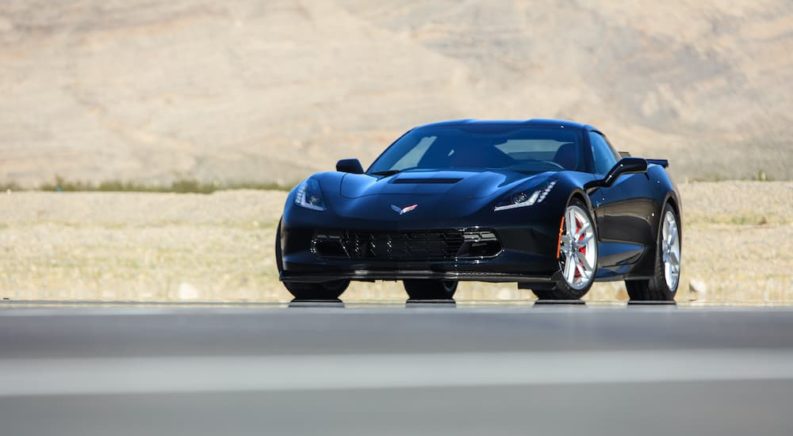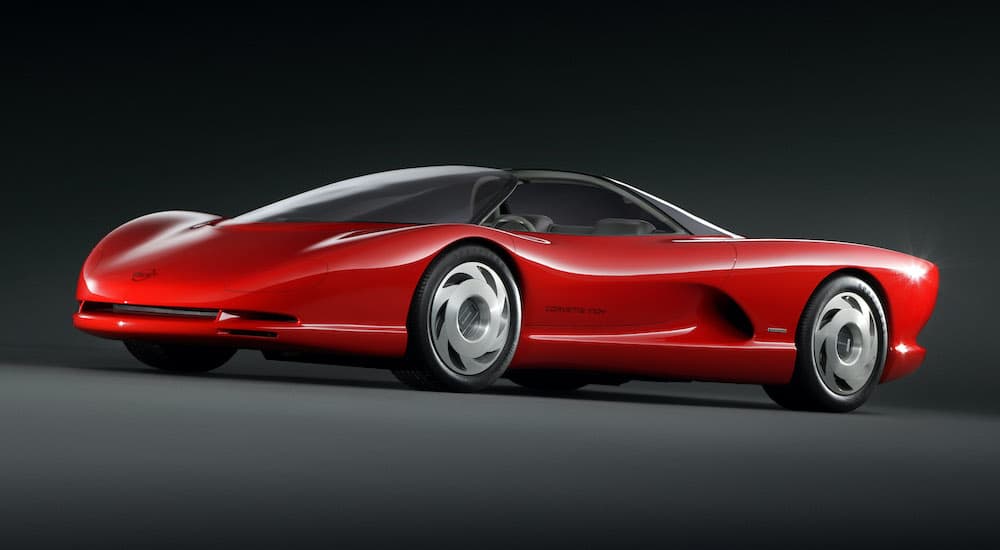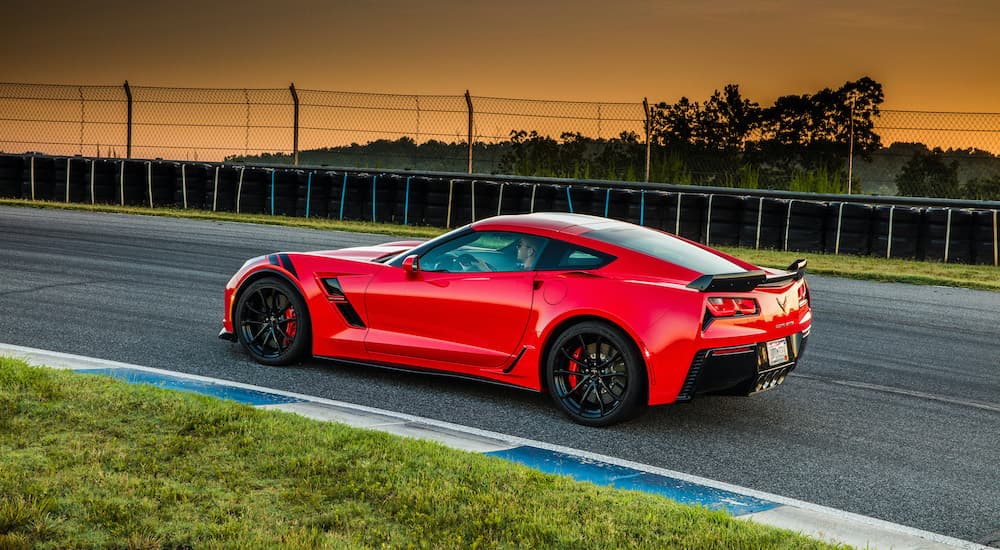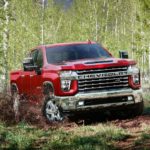Chevrolet’s roots were started in the heart of one of the greatest race drivers of all time when Louis Chevrolet was recruited to be a founding member of a motor company. Louis Chevrolet has been granted posthumous recognition for his incredible driving skill and contributions to the automotive world, and he leaves behind the legacy that started Chevrolet’s powerful engines built for speed and durability. Chevrolet’s first vehicle produced for the company bearing his name was the Classic Six, a car that featured a cast-iron six-cylinder engine that made 40 horsepower and could go up to 65 mph, competing with high-performance cars of its day. Today, visiting a Chevy dealer for a high-performance C8 Corvette or watching the Indy 500 pace car head up the pack are part of Chevy history based on a racer’s dream.
A History of Speed
As it stands to date, the Chevy Corvette has served as the pace car for the Indy 500 a stunning 18 times – the most of any car – and Chevrolet has been showcased 32 times over the years at this world-famous race. Despite Chevy being focused on affordable cars for the masses, the automaker has produced generations of fast performance cars, with the Corvette being its most famous. The Camaro has a place as a performance car, too, though the Corvette has always been more aerodynamic and agile, making it a better racer. In fact, the small-block V8 engine, which is found in so many Corvettes, is also the engine that inspired most of Chevy’s stock and drag racers; thanks to that engine design, Chevy has won more NASCAR trophies than any other auto manufacturer.
Small-block V8 engines started showing up in Chevy vehicles in 1955, and in that year, seven out of the top ten racers in a NASCAR race in Darlington, SC, had those Chevy V8s under the hood. After the small-block V8, Chevy went on to the large-block followed by the LS series of V8s, all of which were favored for their aftermarket flexibility for modification. Speed wasn’t the only thing to make those V8s incredible; Chevy won the Le Mans 24-hour endurance race eight times in a span of 16 years, more than any other competitor, with the Corvette. And because the Corvette impressed on the track, it became the focus of one particular auto manufacturer: Callaway, a manufacturer of high-performance packages installed in vehicles after production.
To this day, one of the most well-known Corvettes is the 1988 Callaway Corvette known as “Project Sledgehammer.” Based on the C4 platform, the Sledgehammer held a speed record from 1989 to 2007 as the fastest road-legal car in the world. Now that Chevy is releasing news about its new C8 Z06 Corvette – which can be optioned with a Z07 performance package – the bar continues to rise. Even more interesting is the fact that Chevy engines are found in numerous vehicles around the world, and not just in those manufactured by the Bowtie brand. Of all the Chevy vehicles ever built, which are the fastest? We put together a list of the fastest Chevy vehicles of all time, including those that win at the track.
Some of the Fastest Chevy Cars Ever Built
#10. 1976 Mike Keyser Chevy Monza (Race Car)
This is the only Chevy listed here that has a zero to 60 time over 4.0 seconds, but it also deserves a spot on the list for being commissioned by Al Holbert for racing at the All-American GT after a new class was created in 1975. For 1976, the Monza won the first of its titles with Lee Dystra’s design. The 1976 Monza boasts a zero to 60 time of 4.7 seconds and a quarter-mile time of 12.1 seconds.
#9. 1986 Chevrolet Corvette Twin-Turbo (Prototype)
Though this Corvette never made it past the prototype stage, it was almost used as an Indy 500 pace car until the engineers realized they might ruffle feathers by producing a turbocharged ‘Vette next to the stock ‘Vettes they had been showing off during the week before the race. Unfortunate, since the Twin-Turbo could make zero to 60 time of 3.9 seconds and had a quarter-mile time of 11.6 seconds with its impressive engine design.
#8. 2014 Lingenfelter Chevrolet SS Supercharged
A list of the fastest Chevys wouldn’t be complete without a Lingenfelter or two, and instead of going with one of the ‘Vettes, it seemed prudent to include a Chevy SS built for racing NASCAR with its powerful 6.2-liter LS3 V8 engine that produces 415 hp. Built in Australia, this enhanced streetcar could pull off zero to 60 times of 3.7 seconds and hit the quarter-mile in 11.9 seconds.
#7. 1978 Turbine-Powered Chevrolet Corvette
When an entrepreneur like Herb Orlowitz wants a street-legal turbine-powered sports car, designer Granatelli builds a ‘Vette with a Pratt and Whitney ST6B engine. Why a ‘Vette? Because the long front end was big enough to fit the turbine assembly. Official zero to 60 times are 3.6 seconds, but Granatelli reported a 2.5-second time of his own. Reaching the quarter-mile in 12.0 seconds, this ‘Vette could max out at 180 mph.
#6. 2001 Chevrolet Corvette C5-R (Race Car)
Corvettes make excellent racers, as they have for decades, and this particular fifth-gen ‘Vette was created specifically for the track. With several titles to its name, the C5-R is reported to be one of the highest-winning GT cars from races like 12 Hours of Sebring, 24 Hours of Le Mans, and 24 Hours of Daytona. Dale Earnhardt and his son both drove this model year, and Pratt & Miller won six times in a 2001 C5-R. With zero to 60 times of 3.4 seconds and the quarter-mile in 10.2 seconds, this ‘Vette is an impressive winner.
#5. 2011 Chevrolet SLP Camaro ZL1
Only 69 units of this special edition Camaro were produced in honor of the ’69 ZL1 Camaro anniversary, which featured a 427-cubic-inch aluminum V8 just like its original. The one big difference between the two cars was the increased horsepower up to 750 and the capability to hit 205 mph, partially thanks to Blackwing cold air induction and a supercharger, among other mods. A rapid zero to 60 time of 3.1 seconds could be achieved in the SLP Camaro, and it could hit the quarter-mile in 11 seconds flat.
#4. 2015 Chevrolet Corvette Z06 (Z07 Package)
Though it seems like old news, the Z07 package was only introduced in 2015. MotorTrend sang its praises for being a finely-tuned sports car that could hit speeds as high as 186 mph, with the Z07 package adding its carbon fiber fittings to its already lighter aluminum frame. With zero to 60 times of 3.0 seconds and the quarter-mile mark coming in at 11.0, the Z07 package proved its worth for its introduction into the world of the Corvette.
#3. 2020 Chevrolet Corvette Stingray Z51
When Chevy moved the engine to the middle of the Corvette for the 2020 model year, it was a labor borne of years of engineering. Chevy knew that if the ‘Vette was going to compete with world-class European sports cars, the engine would have to move behind the driver. So, the Stingray returned with its 6.2-liter LT2 V8 to rival the Ferraris and Lambos in the streets with zero to 60 times of 2.8 seconds and the quarter-mile at 11.1. Impressive, indeed.
#2. 2001 Lingenfelter Corvette 427
Now we come full circle with the inclusion of the Lingenfelter ‘Vette that restored the 427 engine even though Chevy vowed never to put another under the hood of a Corvette again. Except that Lingenfelter put a twist on the former big-block V8 and instead replaced it with the LS1 small-block forged of aluminum. With such light feet, this ‘Vette whips up zero to 60 times of 2.0 seconds and blasts through the quarter-mile in 9.2 seconds.
#1. 1999 Chevrolet S-10 NHRA Pro Stock Race Truck
As a fun surprise, the vehicle taking first place for speed isn’t a car. To race this Chevy S-10 like a true pro, it takes the kind of skill that most people can’t even imagine, much less execute. The zero to 60 time of 1.1 seconds seems impossible, and yet it’s true. And hitting the quarter-mile at 7.6 seconds seems equally improbable unless you see it happen…if you can see the blur the truck becomes after the driver hits the gas.






